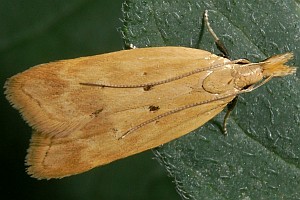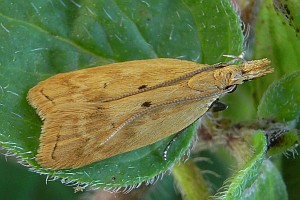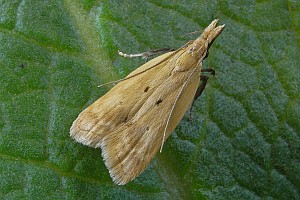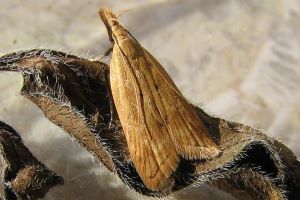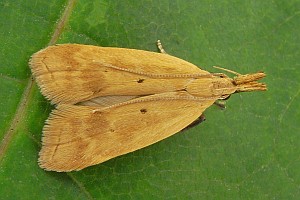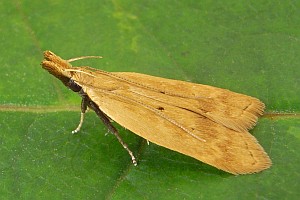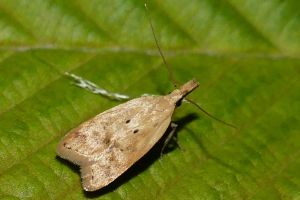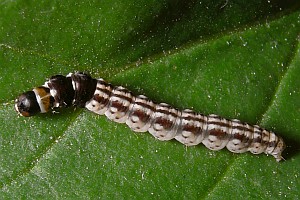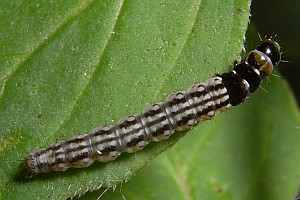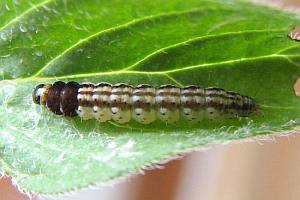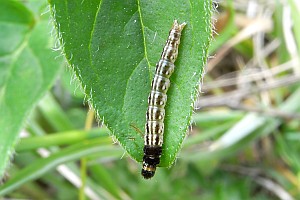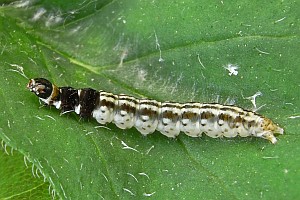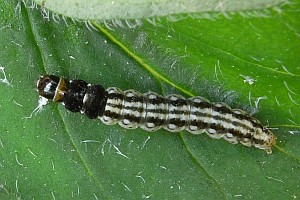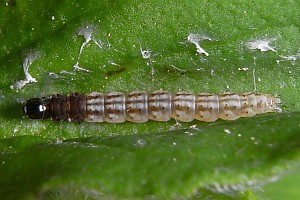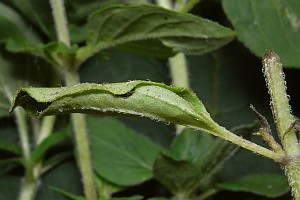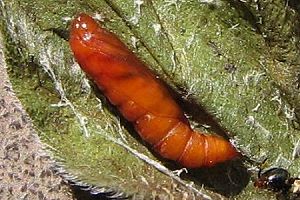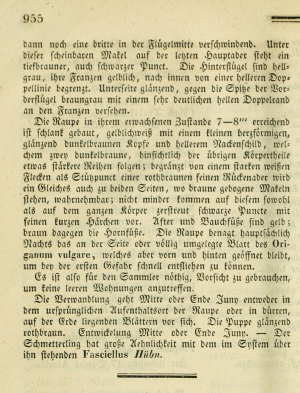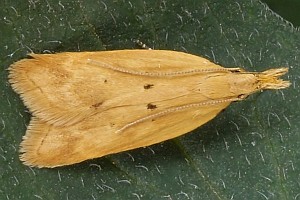
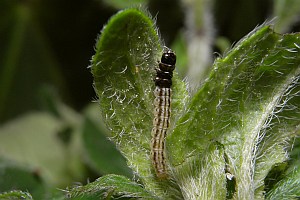
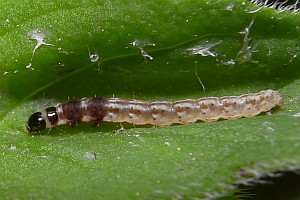
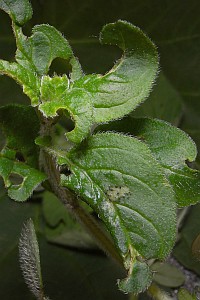
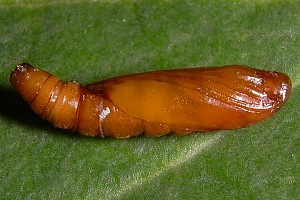
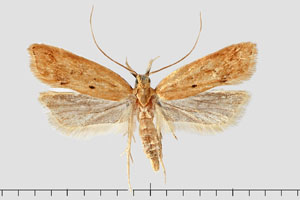
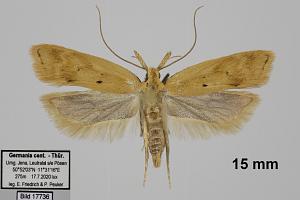
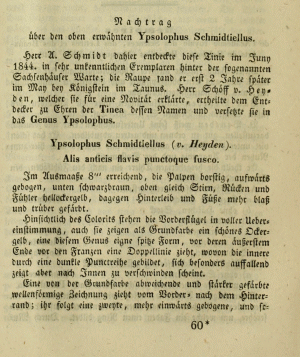
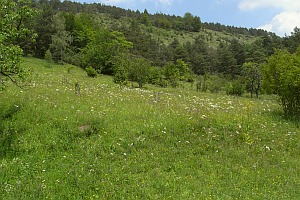
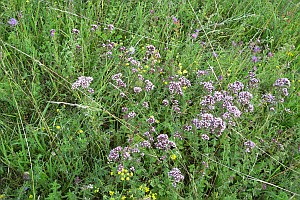
1. Lebendfotos
1.1. Falter
1.2. Ausgewachsene Raupe
1.3. Jüngere Raupenstadien
1.4. Fraßspuren und Befallsbild
1.5. Puppe
2. Diagnose
2.1. Männchen
2.2. Weibchen
2.3. Erstbeschreibung
3. Biologie
3.1. Habitat
3.2. Raupennahrungspflanzen
- andere Lippenblütler wie Mentha, Calamintha
3.3. Nahrung der Raupe
- [Lamiaceae:] Origanum vulgare (Dost)
- [Lamiaceae:] Clinopodium vulgare [= Calamintha clinopodium] (Wirbeldost)
- [Lamiaceae:] Calamintha nepeta ? (Kleinblütige Bergminze ?)
- [Lamiaceae:] Mentha arvensis ?? (Acker-Minze ??)
- [Lamiaceae:] Mentha longifolia ?? [= Mentha sylvestris ??] (Ross-Minze ??)
- [Lamiaceae:] Mentha x rotundifolia ?? (Rundblättrige Minze, Apfel-Minze ??)
Schütze nennt nur den Dost: "An Origanum in einem umgeschlagenen, vorn offenen Blatt. Verwandlung in der Erde (Rössler)." Origanum vulgare ist die mit Sicherheit wichtigste Nahrungspflanze der Art.
Huemer & Karsholt (2002) schreiben zum momentanen Kenntnisstand: "The larva feeds until June on Origanum vulgare L. (Lamiaceae), folding a leaf and spinning it together, only leaving a small entrance in each end, through which it rapidly disappears if disturbed. It is active preferably during the night. Lhomme (1948: 660) also recorded Mentha arvensis L., M. silvestris L., M rotundifolia L. and Calamintha nepeta (L.) Savi (Lamiaceae) as host plants, and it was bred from Clinopodium vulgare L. (Lamiaceae) in Portugal (Corley et al 2000: 269)." Zumindest die Angaben zu den Arten der Gattung Mentha erscheinen mir nicht abgesichert.
(Autor: Erwin Rennwald)
4. Weitere Informationen
4.1. Andere Kombinationen
- Ypsolophus schmidtiellus Heyden, 1848 [Originalkombination]
- Telephila schmidtiellus (Heyden, 1848) [so in Karsholt & Razowski (1996)]
4.2. Synonyme
- Ypsolophus durhamellus Stainton, 1849
- Hypsolopha quadrinella Herrich-Schäffer, 1854
4.3. Literatur
- Bengtsson, B. Å. (2022): Anmärkningsvärda fynd av småfjärilar (Microlepidoptera) i Sverige 2021. — Entomologisk Tidskrift 143 (1-2): 1-16. [Sekundärzitat, Abstract auf et-online.nu]
- Corley, M. F. V., Gardiner, A. J., Cleere, N., & P. D. Wallis (2000): Further additions to the Lepidoptera of Algarve, Portugal (Insecta: Lepidoptera). — SHILAP Revista de Lepidopterología 28 (111): 245-319.
- Huemer, P. & O. Karsholt (2002): A review of the genus Acompsia Hübner, 1825, with description of new species (Gelechiidae). — Nota lepidopterologica, 25 (2/3): 109-151. [PDF auf us.archive.org]
- Erstbeschreibung: Koch, G. (1848): Die Raupen und Schmetterlinge der Wetterau, insbesondere der Umgegend von Frankfurt und der östlichen Abdachung des Taunusgebirges. — Isis von Oken 1848 (11): 891-955. Leipzig (Brockhaus).
- Paulavičiūtė, B. (2021): Data on 3 new and 6 rare Gelechiidae moths species (Lepidoptera: Gelechiidae) for Lithuania. — Bulletin ot the Lithuanian Entomological Society 3 (31): 68–72. [Zum PDF auf hpm.hr]
- [SCHÜTZE (1931): 166]



![Vorkommen in Österreich [Huemer (2013: NR 1279)]](/res/img/flag/at.png)
![Vorkommen in Liechtenstein [Hiermann & Mayr (2023)]](/res/img/flag/li.gif)
![Vorkommen in Dänemark (außer Färöer-Inseln und Grönland) [Aarvik & al. (2017): Nordic-Baltic Checklist]](/res/img/flag/dk.gif)
![Vorkommen in Schweden [Bengtsson (2022)]](/res/img/flag/se.gif)
![Vorkommen in Russland (europäischer Teil bis Manytsch-Niederung) [Sinev (2021)]](/res/img/flag/ru.gif)
![Vorkommen in Litauen [Paulavičiūtė (2019)]](/res/img/flag/lt.gif)
![Vorkommen in Tschechien [Laštůvka, Z. & J. Liška (2011): Komentovaný seznam motýlů České republiky]](/res/img/flag/cz.gif)

![Vorkommen in Ungarn [Pastorális et. al. (2018): A Magyarországon előforduló molylepke-fajok névjegyzéke]](/res/img/flag/hu.gif)
![Vorkommen in Großbritannien [Agassiz, Beavan & Heckford (2013): Checklist of the Lepidoptera of the British Isles]](/res/img/flag/gb.gif)
![Vorkommen in Belgien [De Prins(2016): Catalogus van de Belgische Lepidoptera]](/res/img/flag/be.gif)
![Vorkommen in den Niederlanden [Kuchlein & de Vos (1999): Annotated Checklist of the Dutch Lepidoptera]](/res/img/flag/nl.gif)
![Vorkommen in Luxemburg [Hellers (2018): Gelechiidae]](/res/img/flag/lu.gif)
![Vorkommen in Frankreich (europäisches Territorium ohne Korsika) [Vandromme et al. (2020): Liste systématique et taxinomique des Lépidoptères de France]](/res/img/flag/fr.gif)
![Vorkommen in Andorra [Vives Moreno A. (2014)]](/res/img/flag/ad.gif)
![Vorkommen in Spanien (Festland) [Vives Moreno A. (2014)]](/res/img/flag/es.gif)
![Vorkommen in Portugal (Festland) [Corley (2015): Lepidoptera of Continental Portugal]](/res/img/flag/pt.gif)
![Vorkommen in Italien (Festland und kleine festlandsnahe Inseln) [Baldizzone et al. (1995): Checklist delle Specie della Fauna Italiana 83]](/res/img/flag/it.gif)
![Vorkommen auf Sardinien [Baldizzone et al. (1995): Checklist delle Specie della Fauna Italiana 83]](/res/img/flag/it-sar.png)
